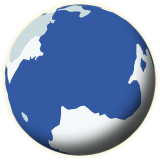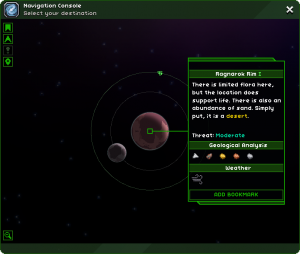Planets
Planets are the primary location of gameplay in Starbound. Almost every element of a planet is procedurally assembled by the game's engine. These elements include a planet's terrain, layers, biomes, sub-biomes, weather, gravity, difficulty, plants, trees, and the appearance and behavior of its fauna.
Every planet has unique coordinates in the navigation console. These coordinates act as seeds to the game's internal random number generator, and as such, will always produce an identical planet when used. There are 12.667 quadrillion planets able to be generated within the game currently, with 422.22 quadrillion planned.[1] According to SteamSpy, there are also approximately 3,172,227 copies of the game currently in existence on Steam (bought games and games activated via key) as of April 1st, 2018.[2]
When on the surface of a planet, nearby planets within the currently occupied star system can occasionally be seen. These planets' appearances are determined by their biome, size, and current distance from the player. The player can continue in one direction on a planet and appear in the position that they began in, implying that these planets are spherical. How far one has to travel is dependent upon the planet's size.[3]
Contents
Planet Generation
There are four possible sizes for each world. The size of a Planet not only affects their circumference, but also the distance to the magma core as well as the distance to the upper atmosphere (space layer). Planets come in 3 sizes, and their Moons come in 4, smaller, sizes. All worlds except Barren, Moon, and Tentacle share the same basic data when it comes to determine the planet's size.
All planets have a maximum depth you can descend before it becomes impossible to teleport back to the ship without the use of a Teleporter if you are playing a Survival or Hardcore character (above this depth, all characters can beam up to their ship if their mouth is not overlapping any background blocks). This is determined by the thickness of the planet's subsurface layer. Once the sub-surface layer is passed, the player enters the underground layers, and teleportation is no longer possible for non-Casual players. The underground is divided into 3 layers, and each layer has a diferent set of underground layers which may appear.
Here are some facts that apply to all worlds (excepting Moon, Barren, and the Tentacle):
- The space layer is roughly 1100 blocks above the surface of the planets. This size of this layer varies but it allow players to build among asteroids. There is also a different Asteroid Field world available to players which is even bigger than the space layer on planets.
- All planets generate large, flying, procedurally generated monsters in the atmosphere layer, roughly 500 blocks above the planet's surface.
- Each secondary biome generated on a planet covers 50-80% of the area covered by the primary biome.
- Each sub-biome generated for a primary or secondary biome covers 25-40% of the area that the parent biome would cover if it had not generated sub-biomes.
- The subsurface (the lowest point you can teleport out) ends 100 blocks below the bottom of the planet's surface.
- The core of every planet begins at y=0 and ends at y=200, and a magma ocean occupies the bottom 30 blocks of the core layer. (The y-coordinate increases as one moves toward the space layer from the bottom of the core layer.) If you go below y=0 for any reason, the game will instantly kill you.
Before version 1.3, you could determine the planet size by looking at the number of blocks/sectors it displays, but with the revamped navigation system, you now can't. If you have a Terraformer and still wish to know its size, you can measure how much essence fully terraforming the planet takes. 5000 Ancient Essence terraforms 1000 sectors of the surface; if you would need to run the terraformer six times to fully terraform a world, you are on a Large Planet.
The following planet properties by size are the default properties of planets with certain sizes. Planet types like Garden planets and all ocean-type planets override some of these defaults with other values.
| size | width | height | village or dungeon | secondary biomes | space layer y | atmosphere layer y | surface layer y | average surface altitute | subsurface layer y | shallow, mid and deep underground layers thickness and y |
|---|---|---|---|---|---|---|---|---|---|---|
| Very Small | 1000 | 2000 | 1 | 0 | 1700~2000 | 1100~1700 | 600~1100 | 675 | 500~600 | 100 each, y=200~500 |
| Small | 3000 | 2000 | 1 | 1 | 1700~2000 | 1100~1700 | 600~1100 | 675 | 500~600. Once you go below the surface/subsurface it is 300 to the core of the planet (clarify?) | 100 each, y=200~500 |
| Medium | 4000 | 3000 | 1-2 | 1-2 | 2000~3000 | 1400~2000 | 900~1400 | 1000 | 800~900 | 200 each, y=200~800 |
| Large | 6000 | 3000 | 2-3 | 1-2 | 2000~3000 | 1400~2000 | 900~1400 | 1000 | 800~900 | 200 each, y=200~800 |
Planet Types
A planet's type dictates its major biome and its smaller biomes (collectively, its environment). A planet's tier dictates its relative difficulty compared to other planets. The types of planets, grouped by threat level, are:
- No threat level: Gas Giant
- Unknown: Moon
- Low (Tier 1): Ancient Gateway, Asteroid Field, Barren, Garden
- Moderate (Tier 2): Desert, Forest
- Risky (Tier 3): Ocean, Savannah, Snow
- Dangerous (Tier 4): Jungle, Mutated, Toxic
- Extreme (Tier 5): Arctic, Midnight, Tundra
- Inconceivable (Tier 6): Scorched, Magma, Volcanic
In the galaxy view of the Navigation Console, all planets with the exception of an Ancient Gateway, Gas Giant and Asteroid Field appear as a small circle orbiting their host star. Ancient Gateways have the appearance of a gate, Gas Giants have an icon of a larger circle and an Asteroid Field has a collection of tiny circles (representing asteroids). Gas Giants can in turn generate further planets and moons as satellites.
Environment
Each planet has an environment made up of a number of elements. The background, terrain type, plant type, weather and trees are called the biome of the planet. While these biomes have similarity between planets (for instance Forest Biomes all have a large number of trees), they are unique in their combination of smaller elements through procedural generation.A world has a dominant, primary biome which is what you see when looking at the planet from the navigation console. Depending on its size, it may have other types of planetary biomes as a secondary biome. For example, Garden worlds may have regions that are Forest biomes. These regions in turn determine which minor biomes can appear. A Forest world may have a Swamp minor biome. Likewise, a Garden world with a Forest secondary biome can have swamps, too.
Underground layer type is independent of the surface biomes present on the planet and planetary difficulty for most planets (Garden and Barren planets are the significant exceptions). Most planets choose one of several underground layer types for subsurface, shallow underground, mid underground, and deep underground layers and one of three layer types for the core layer. For all underground layers (but not subsurface or core layers), an underground cave biome can be chosen in place of a generic underground layer type.
A planet's temperature might be too cold or too hot for the player to survive normally. Such planets require cold protection or heat protection to navigate without taking damage. Similarly, there are other conditions that may make a planet dangerous, such as a lack of atmosphere or intense radiation.
See EPP for the different biome protective pack upgrades.
The color of light on planets is determined by the color of the closest star(s). Its intensity is determined by the distance and size of the neighboring stars.[4] The star pattern in the night sky around a planet is unique and slowly rotates in the sky. If the player returns to the same planet, the stars will be the same.[5]
The length of the planet's day is somewhere between 700 and 1000 seconds. The chosen number is divided by 60, rounded, and displayed in the planet view of the navigation console in units of Sols (equivalent to real-world minutes). Due to rounding, the day length in units of Sols can be any integer between 12 and 17.
The planet's materials are determined by the biome type of the planet, its secondary and minor biomes, and the types of other layers present on the planet.
Difficulty
Difficulty is related to the health and damage of enemies, as well as planetary conditions. Difficulty is split into 7 ranks: Low, Moderate, Risky, Dangerous, Extreme, Inconceivable, and Unknown. Many planets marked at Dangerous difficulty and above require the player to have a specific type of protection pack to explore normally. The only other difficulties requiring an EPP at all locations on a world are the Unknown difficulty, specific to Moons, and the Low difficulty, which Asteroid Fields possess. (The space layers of all planets require an EPP for prolonged trips.)
Monsters
Several Monsters are uniquely generated for each biome on a planet, one for each kind of monster that inhabits the biome. Monsters have levels of difficulty that correspond to the planet difficulty level. Monsters can also have special abilities like Body Slam, Charge, etc.
Planets will also have smaller friendly critters; these are unique to each biome and are non-hostile.
Traveling from planet to planet is done using the ship's navigation console. Traveling to other planets within the same solar system (orbiting the same star) has no fuel cost.
After completing the quest The Erchius Mining Facility the ship's FTL drive can be repaired enabling travel to other star systems. Fuel costs change based on the destination (the fuel cost without Mechanics for each trip is 100), and some planet types (like Gas Giants) and stars cannot be visited directly.
Reset
It is possible to reset or regenerate a planet to its pristine, original condition. To do so, the save file for that planet must be manually located and deleted. It can be found in the <starbound>/storage/universe folder. The specific planet file will be named by its coordinates. Alternatively, the entire universe can be reset by deleting the folder.[6] This can be especially useful in case of major biome updates, in which previously visited worlds have received new content.
Sources
- ↑ http://community.playstarbound.com/index.php?threads/a-little-perspective-on-the-size-of-starbound.27178/#post-1063769
- ↑ http://steamspy.com/app/211820
- ↑ http://www.reddit.com/r/IAmA/comments/1ccf2l/we_are_chucklefish_games_developers_of_indie_game/c9f771h
- ↑ http://playstarbound.com/16th-july-progress/
- ↑ http://www.reddit.com/r/starbound/comments/1jq4n4/4th_august_progress/cbhbho5
- ↑ http://community.playstarbound.com/threads/is-there-a-way-to-make-the-restart-the-planets.96262/#post-2578932




